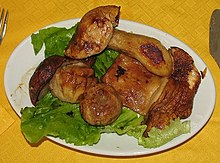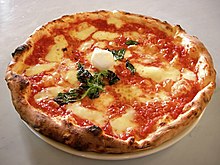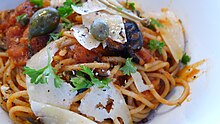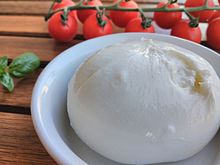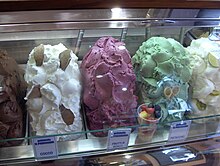Italian kitchen


The Italian cuisine consists of a variety of regional cuisines , and due to the geographical location and long cooking tradition in Italy can draw on numerous ingredients and specialties. Historically, a distinction is made primarily between the Cucina alto-borghese (which describes the exclusive cooking tradition of the higher classes since the Renaissance ) and the Cucina povera (the regional rural and urban cuisine). In addition, there is the rich local wine selection (for example Chianti and Barolo ). In Italy, dinner is usually the main meal, which consists of a starter ( antipasto ), two main courses and the dessert.
Like few other culinary traditions, Italian cuisine has spread around the world since the 2nd century, and its most famous dishes, such as pasta and pizza, are now prepared on every continent. Other internationally known products are Italian olive oil , various types of cheese (for example Parmesan , Mozzarella , Gorgonzola ), as well as sausages and meat products (such as mortadella , salami , San Daniele ham , Parma ham ). Since 2010, Italian cuisine has been on the UNESCO list of the Intangible Cultural Heritage of Humanity .
Regional kitchens
Italy is a large country with different climatic and geographical conditions and with different ethnic groups. The individual regions often had independent historical developments. These circumstances mean that the individual regions - often even individual cities and towns - have produced different culinary specialties and the regional cuisines are so different, so diverse that one cannot actually speak of an "Italian cuisine" .
The following regional cuisines can be distinguished: Friuli ( see: Friulian cuisine ), Veneto , Trentino-South Tyrol ( see: South Tyrolean cuisine ), Lombardy , Aosta Valley , Piedmont , Liguria ( see: Ligurian cuisine ), Emilia-Romagna , Tuscany ( see: Tuscan cuisine ), Umbria , Marche , Latium with the capital Rome , Abruzzo with Molise , Campania ( see: Campanian cuisine ), Apulia , Basilicata , Calabria and the regional cuisine of the two islands of Sicily ( see: Sicilian cuisine ) and Sardinia .
Italian menu sequence
Even in everyday private life, in all Italian regions, meals for lunch and dinner are usually divided into two courses, namely the carbohydrate-based first course ( Primo piatto ) and the protein-rich second course ( Secondo piatto ) . Before this, cold or warm starters ( antipasti ) are often served, followed by desserts ( dolci ) . The meal usually ends with an espresso ( caffè ) . On festive occasions, instead of the courses just mentioned, different dishes are often served to choose from or one after the other.
- Antipasti (starters)
Before the main courses, it is common in Italy to serve various small, mostly light dishes. On a larger scale, you start with cold antipasti, followed by warm antipasti. There is a large and regionally different variety of dishes. In coastal areas, seafood-based antipasti are often served, while otherwise cold cuts and ham are common. Unlike in other countries, cheese is also one of the antipasti. There are also numerous starter dishes based on vegetables.
- Primo piatto (first main course)
The first main course usually consists of a pasta or gnocchi dish. Risotto is often served, especially in northern Italy . Various soups - cream , zuppe or minestre - can also be served as the first course. The Primi piatti also include salads made from pasta or rice.
- Secondo piatto (second main course)
The second main course is usually a meat dish or one with fish or other seafood. Also fried or fried food , e.g. B. fried porcini mushrooms ( Fritto di porcini ), cheese or egg dishes can be served as secondo piatto .
Typical dishes
Antipasti (starters)

- Caprese - mozzarella with tomatoes and basil
- Bruschetta or crostini - toasted bread with different toppings
- Bresaola - ham specialty from Lombardy
- Tramezzini - slices of white bread
- Mortadella , salami , coppa , and other cold cuts as a mixed sausage plate as Antipasto all'italiana referred
- Prosciutto crudo ( raw ham , e.g. Prosciutto di Parma or San Daniele ham )
- Prosciutto cotto ( boiled ham )
- Violino Valtellinese - ham specialty from Lombardy
- Verdure in pinzimonio or cazzimperio - marinated vegetables
- Cocktail di gamberi - shrimp cocktail
- Olive Ascolane - stuffed olives , a Marche specialty
- Mozzarelline frit - deep-fried mozzarella
- Pizzette e Salatini - small pizzas
- Tartine or Stuzzichini - appetizers
- Fiori di Zucca or Sciurilli - fried zucchini flowers
- Supplì or arancini - fried, filled rice balls
- Carne Cruda - hand-chopped raw veal with lemon, white pepper, salt and truffle oil or white truffle
- Vitello tonnato - thinly sliced veal slices with a tuna sauce
- Parmigiana
Soups and sauces
- Bagna Cauda
- Brodo di Natale / Brodo ripieno
- Fonduta
- Minestrone
- Minestrina
- Pasta e fagioli
- Pesto alla genovese
- Tortellini in brodo
Pizza
Pizza is usually consumed as a single course ( piatto unico ).
Pasta dishes
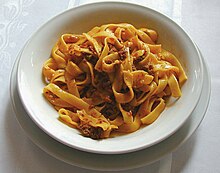
- Bucatini all'amatriciana , Bucatini coi Funghi , Bucatini alla Sorrentina
- Cannelloni al Ragù , Cannelloni ai Carciofi
- Fettuccine Alfredo
- lasagne
- Penne all'arrabbiata , Pansotti alla Genovese
- Rigatoni con la pajata , Rigatoni al Forno con Salsa Aurora
- Tagliatelle al ragù , Spaghetti alla carbonara , Spaghetti alle vongole , Spaghetti aglio e olio , Spaghetti alla Carrettiere , Spaghetti al nero di seppia , Spaghetti alla puttanesca , Spaghetti con la bottarga , Spaghetti Indiavolati , Spaghetti Siracusani , Spaghlioetti allo scoglioetti
- Tagliatelle alla Boscaiola , Tagliatelle ai Carciofi , Tagliatelle ai Funghi , Tagliatelle al Pomodoro , Tagliatelle al Ragù
- Tortelloni alla zucca
- Trofie al Pesto , Trofie al sugo di noci
- Pasta con le sarde
- Pappardelle al sugo di lepre
rice dishes

Rice dishes ( risotti ) are particularly popular in northern Italy, especially in Lombardy and the region around Venice .
- Risotto con Agoni, Risotto al Barolo, Sformato al Basilico, Risi e Bisi, Risotto al Cavolfiore
- Risotto ai Gamberoni, Risotto al Gorgonzola, Risotto indivia e fiori di zucca
- Risotto alla Milanese or saffron risotto, risotto con la luganega, risotto mantecato con Grana Padano
- Risotto alla Marinara, Riso al nero di seppia, Riso con Piselli, Riso con i Porcini
- Risotto saltato, Risotto ai Quattro Sapori, Sformato di Riso Dolce
- Tiella di Riso, Risotto alla Sbirraglia, Risotto con scamorza e champagne, Risotto di Seppie alla Veneziana
- Riso Tonnato, Patate e Cozze, Riso alla Toscana, Riso Valdostano, Risotto allo zafferano con petto d'anatra, Risotto alla Zucca
Fish dishes

- Acciughe frit in pastella, Acciughe in carpione, Acquadella o latterino fritto, Agghiotta di pesce spada, Anguilla marinata
- Baccalà alla vicentina, Baccalà fritto, Branzino al sale, Brodetto di arselle, Burrida
- Cacciucco , Calamaretti fritti, Calamari in zimino, Calamari ripieni, Capesante alla veneziana, Cappon magro, Carpaccio di pesce, Cartoccio di pesce spada, Cozze alla tarantina, Cozze fritte alla viareggina, Cozze ripiene
- Filetti di Baccalà, Filetti di orata al cartoccio, Fritto misto , Frittata di bianchetti, Frittura mista di pesce
- Grancevola alla Veneziana
- Impanata di pesce spada, Involtini di pesce
- Missultin e polenta, Moscardini lessati alla genovese, Murena fritta
- Nasello al forno
- Orata arrosto, Orata al forno, Orata al finocchio
- Pepata di cozze, Pesce a scabecciu, Pesce al cartoccio, Pesce alla pizzaiola, Pesce spada alla siciliana, Pesce spada arrosto in salmoriglio, Polpettine di mare
- Sarde a beccafico, Sarde arraganate (Sarde con origano e pane), Sarde grigliate, Sarde ripiene, Sarde Sfiziose Panate, Sardele in saor, Sbroscia bolsenese, Scampi a zuppetta, Scampi gratinati, Seppie col nero alla veneziana, Seppie con i piselli ripiene, Seppioline in umido, Sogliole alla mugnaia, Spiedini ai frutti di mare, Spiedini di alici, Spiedini di anguilla, Stoccafisso alla genovese, Stoccafisso alla ligure
- Tonno sott'olio, Tortiera di cozze, Triglie alla livornese
- Zuppa di pesce, Zuppa di cozze
Meat dishes
- Agnello al forno - lamb roasted in the oven
- Arrosticini - A grill specialty from Abruzzo
- Arrosto di vitello - roast veal
- Bistecca alla fiorentina - Florentine-style T-bone steak
- Bollito misto - Mixed, cooked meat
- Coda alla vaccinara - braised oxtail
- Costoletta alla milanese - Milanese schnitzel
- Involtini di vitello - Small veal rolls
- Ossobuco - Braised veal shank slices
- Pezzetti di cavallo - Braised horse meat
- Piccione in forno - pigeon roasted in the oven
- Saltimbocca alla Romana - veal schnitzel with ham and sage
- Zampone - stuffed pig's foot
Salumi
Salumi is the Italian word for sausage products , including other cured products
cheese
Italy is one of the countries with the largest number of cheeses and a long tradition in production and processing, see cheese from Italy .
Desserts
- Budino (pudding)
- fruit
- Gelato (Italian ice cream )
- Granita
- Macedonia (fruit salad)
- Panna cotta
- Pignolata
- Sorbet
- Tiramisu
- Uovo sbattuto (mixed egg yolk, sugar and a dash of espresso)
- Zabaglione
- Zuccotto
Bakery products

- Pastries : Amaretti , Cannoli , Cantuccini , Cassata , Colomba pasquale , Crostata , Pandoro , Panettone , Panforte , Profiterole , Sfoglio , Sfogliatelle
- Bread : Ciabatta , Panini , Focaccia , Grissini , Piadina , Vinschgauer
beverages
Wines
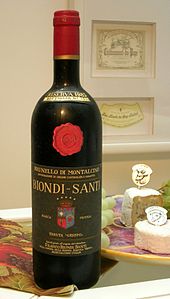
The Italian Wine has a long tradition and each region has its own wines. There are over 350 grape varieties. Due to the different climatic conditions, there are great differences in taste between the wines, which accordingly enrich the regional character of the different cuisines. Qualitatively, a distinction is made between quality wine and country wine and is awarded. More than a fifth of all grape varieties grown in Italy are autochthonous . Sangiovese and Nebbiolo are among the most famous .
The character of the wine decides which course it is served with. The Tuscan Vin Santo , for example, is a dessert wine. In Italy, in addition to still wines ( vini tranquilli ), pearl ( vini frizzanti ) and sparkling wines ( vini spumanti ) are also pressed.
Aperitifs
Some of the most famous liqueurs that are mixed in aperitifs such as the spritz include Campari , Cinzano and Aperol .
Digestifs
- grappa
- Amaro ( herb bitters ), e.g. B. Fernet Branca , Ramazzotti , Averna etc.
- Limoncello
- Brandy , e.g. B. Vecchia Romagna, floor 84
coffee
In the 16th century, coffee was an avant-garde drink in Italian-speaking territory , for example on the campus of the University of Padua . In 1600 Pope Clement VIII decreed that coffee was a drink suitable for Christians. Then the street vendors who also sold lemonade had him on sale. The first Italian-style coffee house to be verified was opened in Venice in 1683. Typical Italian coffee specialties are: Caffè Corretto , Caffè Latte , Latte macchiato , Espresso , Cappuccino .
Projects and heritage
In 1953, on the initiative of Orio Verganis, the Accademia Italiana della Cucina was founded in Milan . This would like to preserve the knowledge of the Italian cuisine and table culture and pass it on to the following generations. To this end, it organizes meetings and conferences, has set up the Franco Marenghi Study Center and awards prizes and awards. The Academy publishes the monthly magazine Civiltà della Tavola . Another project to initially preserve Italian culinary art, the Associazione Slow Food , was founded in 1986 in Bra by Carlo Petrini .
Together with the governments of Spain , Greece and Morocco , the Italian government has applied to UNESCO to include Mediterranean cuisine in the intangible cultural heritage . In November 2010 this application was approved.
literature
- Larissa Bertonasco : La cucina dolce (Text: Carlo Bernasconi) Berlin, Jacoby & Stuart publishing house , 2012. ISBN 978-3-941787-91-9
- Ulrike Thoms: From migrant to lifestyle cuisine: The career of Italian cuisine in Europe , European history online , ed. from the Institute for European History (Mainz) , 2011, accessed on: April 18, 2020.
- Larissa Bertonasco : La cucina verde (Text: Carlo Bernasconi) Berlin, Jacoby & Stuart publishing house, 2010. ISBN 978-3-941087-79-8
- Marcella Hazan : The classic Italian cuisine . Collection Rolf Heyne 2010, ISBN 978-3-89910-479-0
- The silver spoon (Il Cucchiaio d'argento, from 1950) is the most successful Italian cookbook, Phaidon, Berlin, 2007, ISBN 0-7148-9665-9
- Peter Peter : Cucina & Cultura - the cultural history of Italian cuisine . Second edition. Munich 2007. ISBN 3-406-55063-0
- Larissa Bertonasco : La nonna, la cucina, la vita Hildesheim, Gerstenberg Verlag, 2005. ISBN 3-8067-2560-8
- Pellegrino Artusi : The classic culinary art of Italy. From the science of cooking and the art of enjoying , Kosmos Verlag, 2nd edition 2005, ISBN 3-440-10505-9
- Alberto Capatti, Massimo Montanari , La cucina italiana. Storia di una cultura , Roma-Bari, Laterza, 2002. ISBN 978-88-420-7675-9
- Paolo Sorcinelli, Gli Italiani e il cibo. Dalla polenta ai cracker , Milano, Bruno Mondadori, 1999. ISBN 978-88-424-9659-5
- Alice Vollenweider : Italy's provinces and their cuisine , Wagenbach, May 1999. ISBN 3-8031-3052-2
- Cettina Vicenzino: ITALIA - The best from all regions. Christian Verlag, Munich 2016. ISBN 978-3-86244-761-9
- Cettina Vicenzino: DOLCI ITALIANI - Sweet seduction in Italian. Fackelträger Verlag, Cologne 2016. ISBN 978-3-7716-4629-5
Web links
- Cultural institute Academy of Italian cuisine , partly multilingual. Italian recipe page
- Website dedicated to Pellegrino Artusi , his book is available for download (Italian)
- Feasting for the fatherland , articles in time
- Italian cuisine in the Koch-Wiki
Individual evidence
- ↑ Alberto Capatti, Massimo Montanari: Italian Cuisine: A Cultural History , Columbia University Press 1999, p xiii. ISBN 978-0-231-12232-0
- ↑ Brochure of the Italian Institute for Foreign Trade Düsseldorf 2006 (PDF; 3.2 MB)
- ^ Bennett Alan Weinberg, Bonnie K. Bealer: The world of caffeine: the science and culture of the world's most popular drug , Routledge Chapman & Hall, 2001, p. 68. ISBN 0-415-92722-6
- ↑ website of the academy (Italian)
- ↑ Website of the association ( Memento of the original from March 20, 2011 in the Internet Archive ) Info: The archive link was inserted automatically and has not yet been checked. Please check the original and archive link according to the instructions and then remove this notice.
- ^ The Mediterranean diet. UNESCO, accessed on August 11, 2013 .


